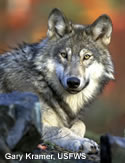 |
WASHINGTON DEPARTMENT OF FISH AND WILDLIFE NEWS RELEASE 600 Capitol Way North, Olympia, WA 98501-1091 |
July 27, 2011
Contact: Susan Galloway, (360) 902-2267
Fish and Wildlife Commission to discuss
wolf management plan, set waterfowl seasons
OLYMPIA — The Washington Fish and Wildlife Commission is scheduled to discuss the Washington Department of Fish and Wildlife’s (WDFW) recommended Wolf Conservation and Management Plan during a special meeting Aug. 4 in Olympia.
The special meeting will be followed by a two-day meeting Aug. 5-6, when the commission is scheduled to take action on proposed 2011-12 migratory waterfowl hunting seasons and changes to cougar hunting regulations.
The commission’s special meeting on the final Environmental Impact Statement/Recommended Wolf Conservation and Management Plan will begin at 10 a.m. Aug. 4 in Room 172 on the first floor of the Natural Resources Building, 1111 Washington St. S.E. The commission will meet at the same location Aug. 5-6, beginning at 8:30 a.m. both days.
Agendas for both meetings are available on the Fish and Wildlife Commission’s website.
During the special meeting Aug. 4, the commission will receive a briefing and take public comment on the recommended Wolf Conservation and Management Plan. The plan is intended to guide state wolf management while wolves naturally disperse and re-establish a sustainable breeding population in the state.
The plan contains recovery objectives that would allow the state to eventually remove wolves from protection lists, along with management strategies to address wolf-livestock and wolf-ungulate conflicts.
The recommended plan was developed after a scientific peer review and extensive public review of the 2009 draft plan. The public comment process, which concluded last year, included 19 public meetings and drew nearly 65,000 responses. In addition, a 17-member citizen Wolf Working Group, which advised WDFW on the plan, met with WDFW staff 10 times from 2007-2011.
WDFW will post on its website the final EIS/Recommended Wolf Conservation and Management Plan on July 28. The website also contains information on the wolf plan development process, including past public input and the scientific peer review.
The commission, which sets policy for WDFW, has scheduled three more special meetings to discuss the recommended Wolf Conservation and Management Plan and take public comment. Those meetings are tentatively scheduled for Aug. 29 in Ellensburg, and Oct. 6 and Nov. 3 in Olympia.
The commission is scheduled to take action on the plan during its December 2-3 meeting in Olympia.
Meanwhile, the commission is scheduled to conduct a public hearing and take action on proposed 2011-12 migratory waterfowl hunting seasons during the Aug. 5-6 meeting in Olympia. Under the seasons proposed by WDFW, waterfowl hunting seasons would be similar to last year.
Also at that meeting, the commission is scheduled to take action on proposed changes to cougar hunting regulations in six counties in eastern Washington, where a pilot project authorizing cougar hunting with the aid of dogs was not extended by the Legislature this year.
WDFW is recommending an increase in cougar hunting opportunities without the aid of dogs in Klickitat, Chelan, Okanogan, Ferry, Stevens and Pend Oreille counties to continue to meet management objectives in those areas.
In addition, the commission will consider a proposal that would modify the criteria for determining when cougars are removed to address public concerns for pet and livestock depredation and personal safety. The proposal would allow for cougar removals when complaints confirmed by WDFW staff exceed the five-year average.
In other action, the commission will consider proposed amendments to the list of game reserves. The proposed amendments would clarify and update the boundary description for Swinomish Spit Game Reserve and eliminate the Ellensburg Game Farm Reserve and South Tacoma Game Farm Reserve.
The commission also will be briefed on the new Discover Pass and the status of key groundfish species in Puget Sound. The commission also will consider for approval WDFW’s proposed 2012 supplemental operating and capital budget requests, as well as the department’s legislative proposals for 2012.

